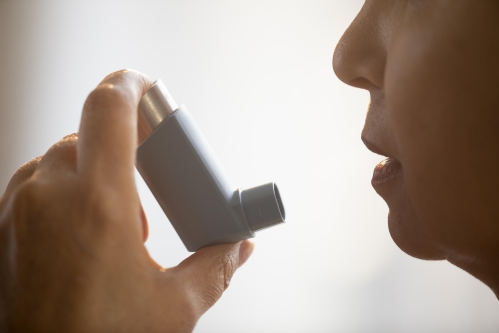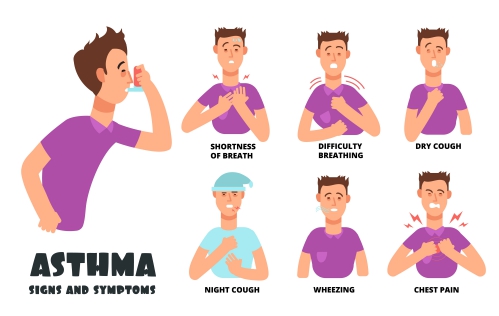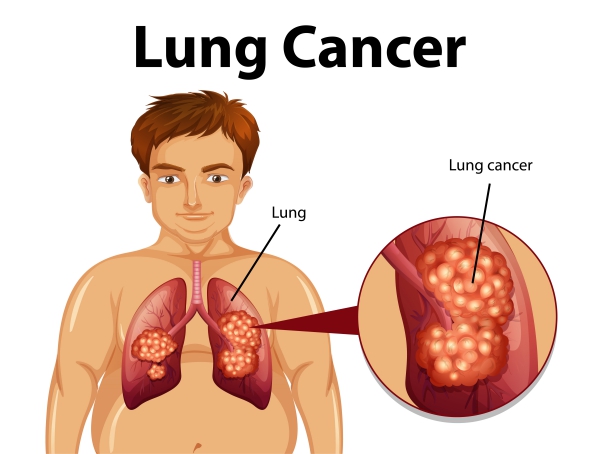What is asthma?
Asthma is a condition in which inflammation causes your airways to narrow and swell. There may be increased mucus production in your airways as well. An asthma attack or exacerbation leads to breathing difficulties, cough, shortness of breath and wheezing (a whistling sound upon breathing).
Asthma can affect your daily activities and can also be life-threatening. According to the centers for Disease Control and Protection (CDC), around 25 million of adults and 7 million of children are affected by asthma in the United States.
For air to reach your lungs, it has to go through your mouth or nose, down your wind pipe and into your airways. Unfortunately, asthma causes narrowing of your airways, making it difficult to get air to your lungs. In addition, mucus fills up your airways causing obstruction which aggravates the situation. However, with proper medication and education about the disease, you can regain a normal life.
Causes of asthma
There are many causes of asthma and some of them are:
- Genetics: if you have a parent or sibling affected by asthma, you are at increased risk of developing it
- Hygiene hypothesis: this is a hypothesis which suggests that when a child is not exposed to enough bacteria in their early years, they are more prone to develop asthma as their immune system is not very well developed
- Atopic dermatitis: this is an allergic condition which is often associated with asthma. Signs and symptoms are red & itchy skin and also hay fever (allergic rhinitis; runny nose and itchy eyes
- History of viral infections: previous infection by Respiratory Syncytial Virus (RSV) during childhood can increase your risk of developing asthma
- Being overweight

In addition, exposure to several substances that usually trigger allergies can trigger asthma. These include:
- Common cold
- Airborne allergens (mold spores, dust mites, pollen and animal dander)
- Physical activity
- Air irritants
- Cold air
- Strong emotions and stress
- Medications (beta blocker, aspirin and non-steroidal anti-inflammatory drugs)
Types of asthma
There are many variants of asthma and the most common one is bronchial asthma where your airways are narrowed making it difficult to breathe. Other types of asthma includes:
-
Intrinsic asthma (non-allergic asthma):
This type of asthma is usually caused by air pollutants such as:
- Cigarette smoke
- Burning wood
- Air pollution
- Cold air
- Air fresheners and perfumes
- Viral diseases

Extrinsic asthma (allergic asthma):
The common triggers of this type of asthma includes:
- Mold
- Pollen
- Animal dander
- Dust mites
-
Occupational asthma:
Common triggers of occupational asthma (workplace such as textiles, farming, manufacturing and woodworking industries) includes:
- Dyes
- Dust
- Fumes
- Gases
- Animal proteins
- Rubber (latex)
- Chemicals (industrial)
-
Medication-induced asthma:
This type of asthma is very severe and occurs within minutes or hours following ingestion of medications such as aspirin and non-steroidal anti-inflammatory drugs (NSAIDS)
-
Exercise-induced asthma (exercise-induced bronchoconstriction):
This type of asthma occurs within minutes after physical exercises where you feel excessive shortness of breath and chest tightness.
Signs and symptoms of asthma
The signs and symptoms of asthma varies from person to person and the main ones are listed below:
- Wheezing (the most common sign of asthma which is a whistling sound made upon exhaling)
- Chest tightness
- Chest pain
- Shortness of breath
- Inability to sleep due to symptoms
- Coughing

If your symptoms are becoming more frequent or if it is more and more difficult for you to breathe, it may be that your condition is worsening and immediate medical attention is required.
Making a diagnosis
To diagnose asthma a combination of medical history, physical examinations and breathing tests (spirometry) is used:
- Medical history: If you have a parent or sibling who suffer from asthma, you are at increased risk of developing asthma. In addition, your doctor will also ask you about any allergies to medications, previous episode of symptoms and other specific questions concerning asthma
- Physical examination: using a stethoscope, your doctor will auscultate your lungs to look for wheezing. Furthermore, signs for atopic dermatitis (allergy) will be searched for.
- Breathing tests: Spirometry is the most common test used. In this test, you will be required to blow air into a device which measures the amount of air exhaled by your lungs.
Classification of asthma
The National Asthma Education and Prevention Program (NAEPP) classifies asthma according to its severity in order to guide treatment. The classification includes:
- Intermittent: most people forms part of this category which does not impair daily activities and symptoms are usually mild, lasting for only 2 days per month
- Mild persistent: symptoms occurs more than twice per week(not daily) or adding up to a total of not more than 4 days per month
- Moderate persistent: People who falls into this category usually experience symptoms daily and at least 1 night per week. Daily activities are often impaired
- Severe persistent: In this category, daily activities are severely affected and symptoms occur several times daily and most nights

Treatment of asthma
Based on your age, trigger and the type of asthma you have, your doctor will recommend a combination of breathing exercises, quick relief medications and long-term asthma control medications:
- Breathing exercises: this can help to increase your lung capacity and help reduce symptoms
- Quick-acting medications: These drugs are used to immediately open your airways or reduce inflammation, allowing you to breathe properly:
Short-acting beta agonists (SABA): These drugs act within minutes to relieve bronchoconstriction (that is, narrowing of airways). Examples are salbutamol and albuterol. In addition, these medications are to be used only to treat asthma attacks.
Oral or intravenous corticosteroids: This class of drugs work by decreasing inflammation inside your airways and lungs, thereby increasing the airflow. They are to be used for a short period of time as they are associated with many side effects. Examples are prednisone and methylprednisolone.

Anticholinergic drugs: These drugs work in the same way as SABAs; they relax your airways. Examples are ipratropium and tiotropium.
- Long-term asthma control medications: once you have been diagnosed with asthma, you will have to take these drugs daily even if there are no symptoms. This is because they decrease the risk of you having an asthma attack. The long-term asthma control medications are:
Inhaled corticosteroids: these medications include budesonide, beclomethasone and fluticasone propionate
Leukotriene modifiers : They are oral medications and includes zafirlukast, montelukast and zileuton
Theophylline: This is a rarely used medication that needs to be used daily. It helps to open airways by relaxing the muscles around them.
Combination inhalers: Examples of combination inhalers are budesonide-formoterol and fluticasone-salmeterol
Complications of asthma
If asthma is not treated properly or not at all, you may suffer from complications such as:
- Inability to sleep due to symptoms
- Frequent hospital and emergency room visits due to asthma attacks
- Inability to perform daily activities (walking, physical exercises, going to school & work)
- Side effects of drugs due to long-term use
Prevention of asthma
Preventing asthma is very difficult, however you can take some steps to prevent asthma attacks such as:

- Follow your asthma treatment plan unfailingly
- Avoid triggers of asthma
- Get your flu shots done
- Identify early signs of asthma
- Consult your doctor again if ever you are using your quick-relief asthma inhaler too often; this means that your asthma is not under control
Prognosis
Each year in the United States around 500,000 hospitalisations are due to asthma and 1.7 million people are treated in the emergency room. Patients with uncontrolled asthma will inevitably suffer from complications or even death. Hence the urge to take asthma seriously and follow the treatment plan with great care.
Source:







